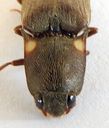Vesperelater
Vesperelater
Classification
- Phylum: Arthropoda
- Subphylum: Hexapoda
- Class: Insecta
- Order: Coleoptera
- Suborder: Polyphaga
- Superfamily: Elateroidea
- Family: Elateridae
- Subfamily: Agrypninae
- Tribe: Pyrophorini
- Genus: Vesperelater
Pronunciation
How to pronounce Vesperelater: /vɛs.pɛ.rɛ.lɑː.tər/
These audio files are automatically generated. While they are not always 100% accurate, they are a good starting point.
Images






Summary
Vesperelater, a genus of bioluminescent click beetles in the family Elateridae, is notable for its unique characteristics and role in the ecosystems of arid regions, particularly in Arizona.
Physical Characteristics
Vesperelater beetles are characterized by their elongated bodies and ability to produce bioluminescence, a common feature among the Pyrophorini tribe.
Identification Tips
To identify Vesperelater species, look for their distinct bioluminescent properties and elongated bodies, as well as specific color patterns that vary among species such as V. arizonicus or V. gemmiferus.
Habitat
Vesperelater species are typically found in arid and semi-arid regions, often in habitats where decaying wood or organic matter is abundant.
Distribution
Primarily distributed in Arizona, USA, with some species having a broader range across North America.
Diet
The larval and adult stages of Vesperelater beetles are generally detritivorous, feeding on decaying plant material and possibly fungi.
Life Cycle
Like other beetles, Vesperelater undergo a complete metamorphosis including egg, larva, pupa, and adult stages.
Reproduction
Reproductive behaviors include mating rituals often featuring their bioluminescent displays during the night to attract partners.
Predators
Predators include birds, mammals, and other insectivorous animals that may feed on adult beetles or larvae.
Ecosystem Role
Vesperelater beetles play a role as decomposers in their ecosystems, aiding in the breakdown of organic matter, thus contributing to nutrient cycling.
Cultural Significance
The bioluminescence of Vesperelater species may have inspired cultural stories and folklore related to fireflies and luminescent insects.
Collecting Methods
- Light traps
- Hand collecting during night hours
Preservation Methods
- Ethanol storage
- Drying and pinning specimens
Evolution
Vesperelater is thought to have evolved from a lineage that included species now classified under the broader genus Pyrophorus, exhibiting adaptations for bioluminescence.
Misconceptions
There may be confusion that Vesperelater beetles are fireflies, when in fact, while both are bioluminescent, they belong to different families and have different life cycle traits.
Tags
- Click beetles
- Bioluminescent
- Coleoptera
- Arizona
- Decomposers